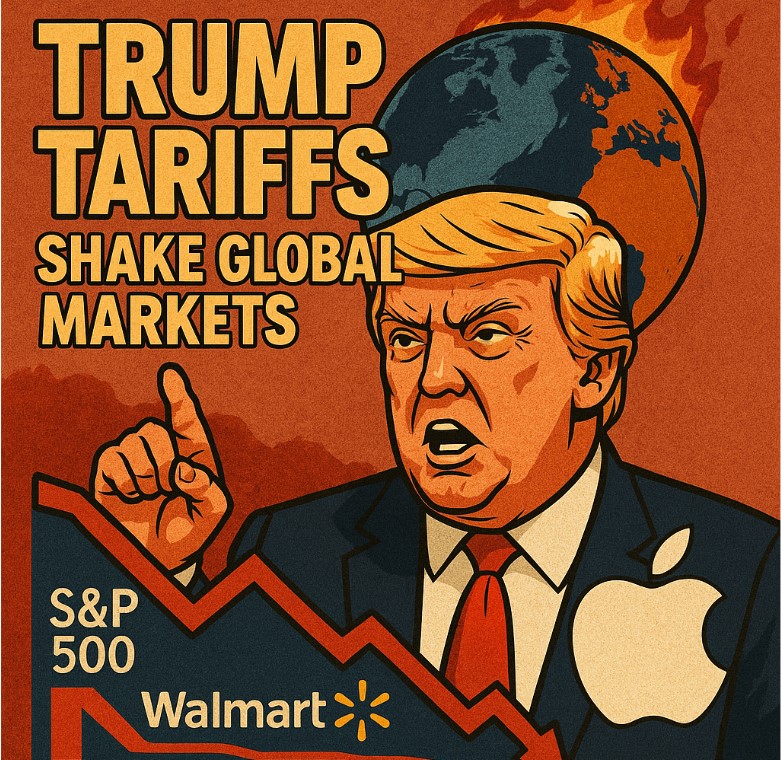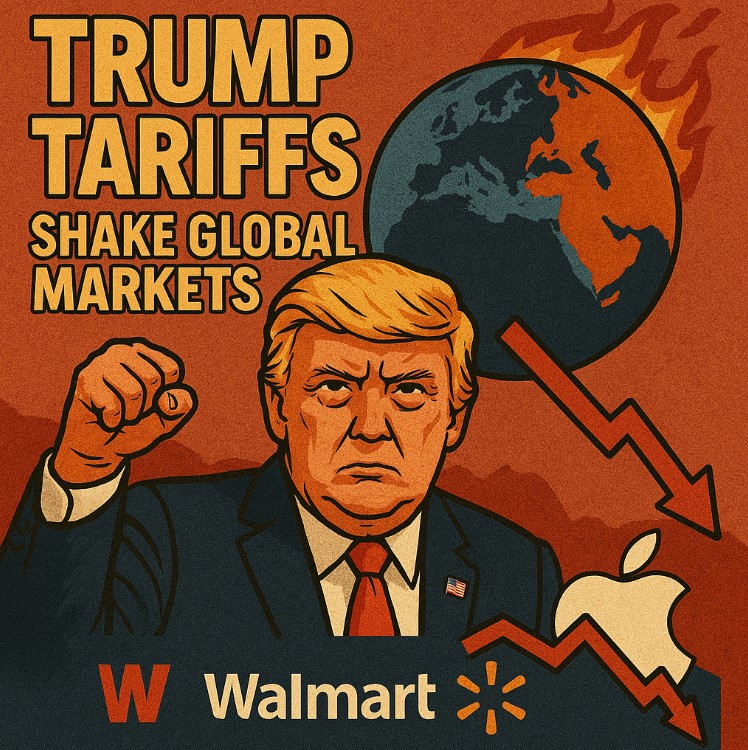
Trump’s Tariffs Shake Global Markets: S&P 500, Walmart, and Apple Feel the Heat 🌍💥
In a move that has sent shockwaves across global markets, President Donald Trump announced on April 2, 2025, a series of tariffs that have left investors and businesses on edge. The U.S. government has imposed a 10% baseline tariff on all imported goods, effective April 5, 2025. In addition to this, the administration has targeted specific countries with higher tariffs, sparking significant market volatility and raising concerns over potential economic slowdowns and trade wars. Major companies, including Apple 🍏, Walmart 🛒, and the broader S&P 500 index 📉, have all felt the heat of these new trade policies.
Trump’s tariffs have sent shockwaves through the markets, challenging global supply chains and raising costs for major companies like Apple and Walmart. As the uncertainty grows, businesses and investors must brace for the long-term impact of these bold trade moves.
The Tariffs Unveiled: A Bold Strategy with Far-Reaching Implications 📊📈
The tariffs imposed by the Trump administration are designed to address the persistent U.S. trade deficit, but their impact is already being felt in the markets. The 10% baseline tariff will apply to all imports from around the globe, but there are additional higher tariffs targeting countries with significant trade surpluses with the U.S. This includes:
- China 🇨🇳: A 34% tariff, totaling a 54% rate when combined with the baseline tariff.
- Vietnam 🇻🇳: A 46% tariff.
- India 🇮🇳: A 26% tariff.
- Taiwan 🇹🇼: A 32% tariff, excluding semiconductors.
- Japan 🇯🇵: A 24% tariff.
- European Union 🇪🇺: A 20% tariff.
These tariffs are not just numbers on a sheet; they represent a serious shift in trade policy that could disrupt supply chains, increase the cost of goods, and lead to inflationary pressures in consumer markets. Companies that have relied on international manufacturing and sourcing are particularly vulnerable, and the stakes are high as the U.S. economy braces for the consequences of these new trade measures.
Immediate Market Reactions: A Sea of Red 🔴📉
The markets did not respond kindly to Trump’s announcement. Within hours of the news, major stock indices plunged:
- S&P 500 📉: Futures dropped by 3.26%, signaling widespread investor concern and the beginning of what could be a prolonged period of volatility in the U.S. markets.
- Apple 🍏: One of the hardest-hit companies, Apple saw its shares tumble by 8.3%. As a company that relies heavily on China for manufacturing, the tariffs could significantly increase its costs and erode profit margins.
- Walmart 🛒: The retail giant, with its vast international operations, also saw a 5.8% drop in its stock price. Walmart’s supply chains are deeply integrated with various countries affected by the tariffs, and the increased import costs are likely to impact its bottom line.
These market drops highlight the immediate effects of the tariffs on corporate America, particularly companies with substantial global exposure. The broader market’s negative response signals that investors are wary of the ripple effects these trade policies will have on the global economy.

The Bigger Picture: What Do These Tariffs Mean for the U.S. Economy? 💸💡
While President Trump’s administration frames these tariffs as a necessary step to protect American jobs and reduce the trade deficit, there are growing concerns about their long-term economic impact. Here are some key takeaways:
- Inflationary Pressures 📈💰: As companies face higher import costs, these increased expenses will likely trickle down to consumers in the form of higher prices. Products across a wide range of industries—from electronics to consumer goods—could become more expensive, leading to inflationary pressures that could squeeze American consumers.
- Supply Chain Disruptions 🛠️🚚: The tariffs are poised to disrupt global supply chains. Companies that have long relied on low-cost manufacturing in countries like China, India, and Vietnam will face higher production costs. This could lead to delays in product availability, shortages, and increased production timelines, further compounding the economic challenges.
- Global Retaliation ⚔️🌍: Countries around the world are already preparing retaliatory measures. The European Union has condemned the tariffs, warning that they could destabilize global trade. Countries like China and Canada have also expressed their intent to impose counter-tariffs, setting the stage for a potential trade war. The ongoing global economic uncertainty raises the risk of further escalation, and the prospects of a prolonged trade conflict could weigh heavily on investor sentiment.
- Impact on U.S. Manufacturing 🏭📉: While the tariffs are designed to protect U.S. manufacturers, the reality is that many of these companies rely on global supply chains to source raw materials and finished goods. Higher costs for these goods could push U.S. manufacturers to raise their prices, potentially making American-made products less competitive in the global market.
- Investor Uncertainty 📉💼: With global markets already on edge, the unpredictability of trade relations can lead to increased market volatility. Companies facing higher operational costs, like Apple and Walmart, will need to adjust their pricing models or absorb the costs, both of which can impact their profitability and stock performance. This uncertainty often leads to investor caution, further adding to market fluctuations.
The Ripple Effects on Other Sectors 🔄📊
Beyond the immediate effects on tech giants and retail companies, other sectors are likely to feel the impact of these tariffs in various ways:
- Technology Sector 💻📱: As seen with Apple, companies in the tech sector that rely on overseas production and components could see their profit margins squeezed. This could also lead to slower innovation and longer product release cycles as companies attempt to navigate the increased cost of raw materials.
- Automotive Industry 🚗⚙️: Many automakers import components from overseas, and the added tariffs will raise the costs of these parts. Companies like Ford, General Motors, and Tesla could face higher production costs, which may be passed on to consumers, potentially slowing demand for new vehicles.
- Retail and Consumer Goods 🛍️📦: Retailers like Walmart, Target, and Amazon, which have extensive global supply chains, will likely face increased costs for their products. This could translate to higher prices for consumers, impacting consumer spending—a key driver of the U.S. economy.
Looking Ahead: What Should Investors Expect? 🔮💼
The announcement of these tariffs marks a new chapter in the ongoing U.S.-China trade saga and highlights the administration’s commitment to a protectionist approach. However, this strategy may come with unintended consequences. Investors should be prepared for heightened market volatility and may want to consider diversifying their portfolios to manage risk.
Some sectors, such as energy and utilities, may be less affected by the tariffs, providing potential investment opportunities in more defensive stocks. On the other hand, sectors like technology and retail could experience short-term declines as the markets digest the full impact of these tariffs.
Conclusion: A Complex Global Landscape 🌐💥
While the tariffs may have been intended to protect U.S. industries and reduce the trade deficit, their far-reaching consequences are already apparent. As major companies like Apple 🍏, Walmart 🛒, and others reel from the impact of these tariffs, global markets are adjusting to the uncertainty of a trade war. Investors, businesses, and consumers must brace for potential disruptions in supply chains, rising costs, and ongoing volatility in the financial markets. The road ahead is uncertain, and only time will tell how these tariffs will reshape the global economic landscape.
Are Rising Tariffs the Price of Protectionism, or Will They Spark a Global Economic Slowdown?
